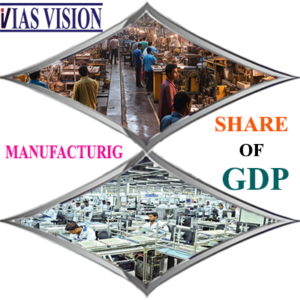Manufacturing share gdp policy growth
Manufacturing policy GDP growth since 1947
Manufacturing sector share in india today
Manufacturing GDP Share India:
After years of missed opportunities & lack of emphasis on exports, in 1991, India opened suspecting doors to the world, not sure what held in store. Till 2000, India took half hearted measures, but post 2000, reforms have been fast, India has giant strides in making sure India is part of new global trade order. Creation of TRAI, IRDA, passage of FRBM act, Golden Quadrilateral, Bharat airman, etc. explains India’s desire and intent.
Manufacturing was further put on fast track by the highly ambitious “Make in India” after which export focus has created increased employment in sectors like automobiles, engineering, chemicals, pharmaceuticals, and consumer durables, which today employs 27.3 million workers. The Indian manufacturing industry/sector currently contributes about 17 percent of the Indian GDP, which is hoped to grow to 21 percent in the next six to seven years. The government wants the Indian manufacturing market to reach around US$1 trillion by 2025-26. and with changes in FDI policy, production incentives, New National Manufacturing Policy, etc. India is gradually progressing on the road to Industry 4.0 through the Government of India’s initiatives like the National Manufacturing Policy and the PLI scheme for manufacturing which was launched in 2022 to develop the core manufacturing sector at par with global manufacturing standards.
India retains 40th rank out of 132 economies in the Global Innovation Index 2023 rankings published by the World Intellectual Property organization.
India ranks 63rd in 2022 from a low of 100 in 2017, in World Bank generated ease of doing Index.
To become a significant player in manufacturing sector India will need to become an attractive option by,
- Creating good infrastructure.
- Reducing import tariffs in line with global standards.
- Automatic investment approvals
- Transparent labor and environment laws.

In recent times, pandemic induced global supply chain disruptions and international trade wars due to artificial entry barriers to certain markets, both of which involved China, have given India opportunity to present itself as a global manufacturing hub.
- The idea of Atmanirbhar Bharat, Make in India, and Vocal for Local has shown the priority the government places on the sector.
- The narrative has started to pay off (has worked in favor of the country) as Samsung, Apple and other technology companies have started manufacturing in India.
- India is biggest investor in infrastructure globally.
- India happens to be the fastest growing economy and holds promise to be so for the next few decades or so.
It is now time for India to seize the moment that history has presented and accelerate its manufacturing engine into high gear.
Indian Industry at independence in 1947
Manufacturing GDP Share India
Though British govt. focused mostly on making India as a place to grow raw materials for British industry and then import British finished goods to Indian market, to the disadvantage of Indian manufacturers, but they left behind a robust manufacturing base. Indian manufacturing base is enlisted below,
- In 1947 when India was partitioned there were 108 jute mills in Bengal but all were located in West Bengal which came to India. They accounted for up to 40% of Indian exports but India’s closed economy made them sick due to a variety of reasons but mostly because of high taxation and lack of imports of machines to remain competitive.
- It was the third largest producer of cotton next to USA and China in the world. India had excess cotton production but lack of finance & incentives and licensing system prohibited setting up of new mills, on other hand govt. did not invest to the extent needed. This explains India regressed in manufacturing.
- India had 54,000 kilometres of railway track, which increased to 108,000KM in 1991. Most of increase happened before 1960.
- India had a functional civil aviation sector, which was nationalized by an act 1n 1955, but was sold off after heavy loss in 2021.
- Iron & steel industry was functioning & competitive to global standards, TATA steel was used to make famous Howrah bridge in Kolkata during 2nd world war.
- India’s share of global trade was around 4.50%, which in 1991 was 0.67%.
- In the first 10 years after independence, India had a current account surplus, but after that till 1991, we never had a surplus.
- promoted industrialization created bloated PSU’s which rarely made profit and could not spur further industrialization.
Critique of post 1947 policies that affected manufacturing sector
Critique of post 1947 policies that affected Manufacturing GDP Share India:
- Reserving large parts of industrial activity fully or partially under state control & monopoly without regard to resources at disposal, there was a large uncertainty and manufacturing industry almost stopped. A somewhat robust private sector slowly regressed.
- went on to nationalize a lot of industries and set up new one, even when there was no expertise available. All steel factories as bokaro, bhilai, etc. failed to make any profit.
- The logic that PSU’s were not for making profit was peddled to hide policy failures, which eventually became burden on state exchequer, and continue to be so even today. Many are being sold today at large losses. I.e. air India.
Post 1947, India having come out of colonial rule and with leaders at the helm having less experience in administration and confidence in capitalistic policies, favored partially controlled socialism, tight licensing policy, etc.
By 1991, thereby crippling the economy with less jobs, persistent fiscal deficits, high inflation (double digit inflation), high poverty (40% people living below the poverty line), low reserves (equivalent to 21 days of imports) ever increasing control of production and money supply, depreciating rupee (from 3.30 to 26.30 to a dollar i.e. 700%), etc eventually reaching a point of bankruptcy, where embracing capitalism was no more a choice but the only option.
